Categories: Featured Articles » Novice electricians
Number of views: 44114
Comments on the article: 2
How to choose a magnetic starter and a circuit breaker for an induction motor
For starting, reversing, forcibly stopping countercurrent asynchronous electric motors, electricians use contactors and magnetic starters. The reliability of the system as a whole, as well as the electrical safety of the service personnel, depend on the correct choice of switching equipment.
Choosing a starter and excess switching current leads to high financial costs, when it is switched, slaps of a higher volume are heard than those produced by small starters. Inadequate switching power starters will not last for a long time, they will warm up, and burn terminal blocks and contacts. As a result contact resistance will grow until the contact disappears completely, which will lead to premature replacement of the device.
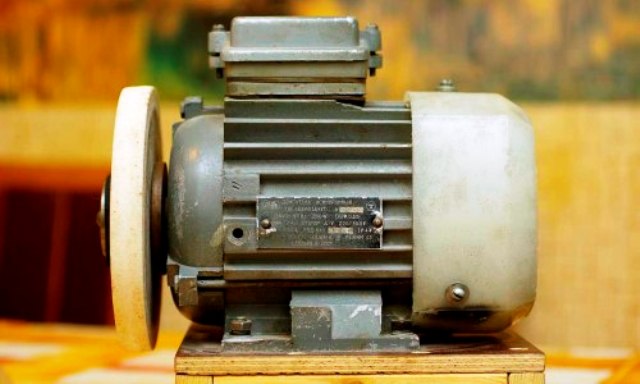
Circuit breakers must also be correctly selected, especially during heavy engine starting. A machine that is too sensitive will be knocked out at start-up, and if it is, on the contrary, taken with an excessive current margin, then in an emergency it may not respond, which will lead to damage to the cable, the motor winding up to fire.
The start for the electric motor is accompanied by an increased current during its acceleration to nominal revolutions, in case of overload and lack of engine power to rotate the actuators, a reduced number of revolutions with increased currents is possible, in the flesh, so that it does not start to spin at all. And vice versa, if the motor power is excessive, then the current consumed by it will be lower than the rated one.
Due to the above reasons, the need arises for the proper selection of starting and protective equipment in the form of magnetic starters, contactors, thermal relays and circuit breakers.
Circuit breakers are installed up to the magnetic starter in order to completely de-energize the system, if necessary, both the power circuit and the control circuit (coil power).
Instead of circuit breakers, fuses or fuses can be used, but recently such solutions are less common than before. This complicates maintenance and makes it necessary to have at least a set of fuses in stock.
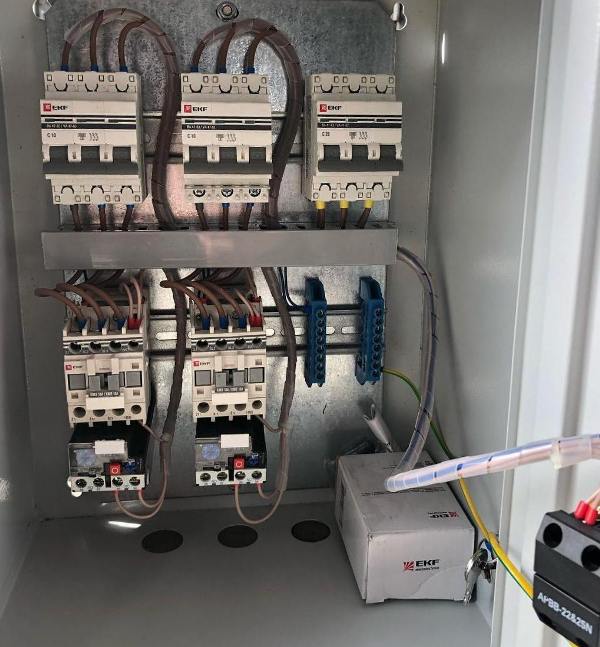
Magnetic starter selection
Magnetic starters are issued for a certain rated current, from a number: 6.3 - 10 - 25 - 40 - 63 - 100 - 160 - 250
Often they are separated not by currents, but by values from 0 to 7, the larger the current (or the magnitude of the starter), the larger its dimensions and contact area. An experienced electrician can distinguish approximate switched current and voltage by the size of the housing, the design of the arrester and the dimensions of the contact pads.
However, if the rated current of the starter corresponds to the current of the motor, this does not mean that they can be used in pairs. If such a concept as a category of application, it characterizes the mode of operation of the switched equipment, the frequency and conditions of switching. In other words, it is the ability to carry inrush currents. Starting currents of an induction motor can exceed nominal and 10 times, it depends on the starting conditions, voltage in the network and other factors.
Application categories are designated: “AC-category number”. A summary table of quantities and application categories for magnetic starters is located below.
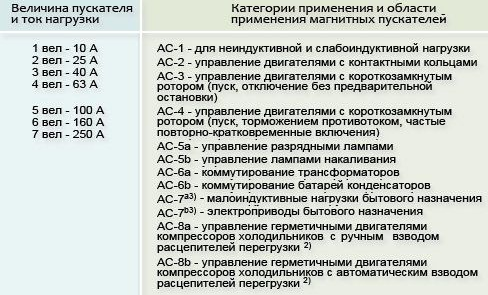
From it we are interested in the line “AC-3 - control of motors with a squirrel-cage rotor (start, shutdown without a preliminary stop)”. From this it is obvious that switching devices with this category are designed to turn the electric motor on and off. They withstand direct start.
Next, you need to determine the rated current of the starter.To do this, we need to know the technical characteristics of the switched motor, namely:
-
η - efficiency%,
-
cos Ф - power factor,
-
P - rated engine power;
-
U - operating voltage (switched);
Then the rated current of the starter is:

For quick calculations, sometimes a different technique is used when the motor power is multiplied by 2 and a rated current is obtained (approximately).
I = P * 2
Next, you need to determine the starting current, in the directories it is indicated either as “k” or as “Iп / Iн". This is the ratio or ratio of inrush current to rated. Shows how much current at start-up exceeds the nominal value.
IP = k * IN
A starter with an AC-3 application category can switch the current 5-7 times more than the rated current, for which purpose it is said I will show in the calculations below.
Choose a starter
Let's say we have an asynchronous motor with a power of 2.2 kW, type 4AM100L6U3. On its nameplate it is written that the efficiency is 81.0%, the power factor is 0.73, I found its technical data on the Internet to find out the multiplicity of the starting current, it turned out to be 5.5
We calculate the current:
1. Fast way: IN = 2.2 * 2 = 4.4A
2. The complicated method: INOM = 2200 / (380 * 0.81 * 0.73 * 1.73) = 5.6A
The results of this calculation gave a greater current.
Now we consider the starting current: IP = 5.6 * 5.5 = 30.8A
We select a starter with a rated current of more than 5.6 A, with an AC-3 application category. As a result of the market review, the PME 111 starter 10A with a thermal relay is suitable for us.
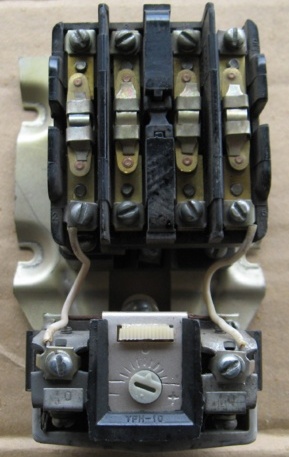
Circuit Breaker Selection
The machine can work when starting or prolonged start-up of the electric motor, when the current consumption significantly exceeds the maximum. In a circuit breaker, two nodes are responsible for protection:
1. Electromagnetic release. It trips at peak current overload. This current depends on the type of machine.
2. Thermal release. Triggered when a slight but prolonged excess of the rated current.
The rated current of the motor we have is 5.6 A, which means we need an automaton no less than this value. Types of automata coke for a downype overcurrent at the peak:
-
type B - 3-5 times;
-
type C –5–10 times;
-
type D - 10-50 times.
Since our starting current is 5.5 times higher than the rated current, this means that an automatic machine of type C and D is suitable for us. For example, the automatic disconnector EZ9F34306 Schneider Easy9, designed for 6 A and its type C, can withstand starting currents up to 60 A.
But such an automaton will work to the limit and the actual current setting can be lower than 5.5, because type C is in the range of 5-10, a current margin of at least 20% is needed.
Therefore, it is better to set the circuit breaker to the same current or a little more, but of type D, for example IEK 6-8A VA47-29

Or for current 10A with type C, for example PL4-C10 / 3 Moeller / Eaton
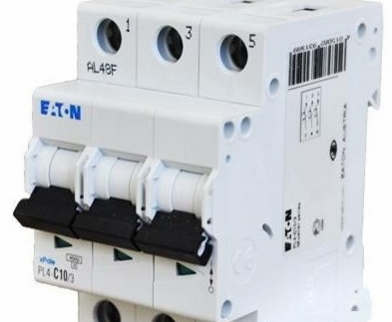
The requirements for the machine are that it stably withstand the rated current, and it is not knocked out at startup. If you plan to operate the engine with frequent on and off, it is better to use a type D machine, it is less sensitive to surges.
Conclusion
A circuit breaker is needed to protect the supply cable and additional motor protection, in the event of a prolonged start or jamming of the shaft, it is additionally better to use thermal protection. The magnetic starter must withstand both the voltage and the current that it will switch.
The electric motor must be in good condition, there should be no short circuits, and its shaft should rotate freely. In the case of starting the engine under load, it is better to take switching equipment with a margin of up to 2 times to reduce the likelihood of premature burning of contacts and false positives of the circuit breaker.
The supply cable must correspond to the rated current, taking into account inrush currents, as well as the method of connecting the cable (using sleeves, lugs, terminal blocks, etc.). The condition of all compounds should be normal - there are no oxides, carbon deposits and other mechanical defects that can reduce the contact contact area.
See also at bgv.electricianexp.com
:
